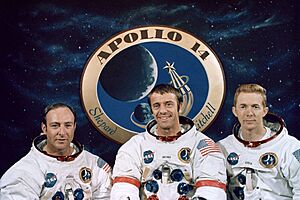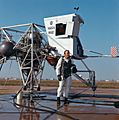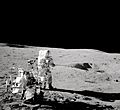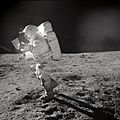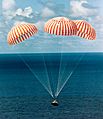Apollo 14 facts for kids

Shepard and the American flag on the Moon during Apollo 14 in February 1971
|
|
| Mission type | Manned lunar landing |
|---|---|
| Operator | NASA |
| Mission duration | 9 days, 1 minute, 58 seconds |
| Spacecraft properties | |
| Spacecraft |
|
| Manufacturer | CSM: North American Rockwell LM: Grumman |
| Launch mass | 102,084 pounds (46,305 kg) |
| Landing mass | 11,481 pounds (5,208 kg) |
| Crew | |
| Crew size | 3 |
| Members | |
| Callsign |
|
| Start of mission | |
| Launch date | January 31, 1971 |
| Rocket | Saturn V |
| Launch site | Kennedy LC-39A |
| End of mission | |
| Recovered by | USS New Orleans |
| Landing date | February 9, 1971 |
| Landing site | South Pacific Ocean 27°1′S 172°39′W / 27.017°S 172.650°W |
| Orbital parameters | |
| Reference system | Selenocentric |
| Pericynthion | 16.9 kilometers (9.1 nmi) |
| Apocynthion | 108.9 kilometers (58.8 nmi) |
| Period | 120 minutes |
| Lunar orbiter | |
| Spacecraft component | Command and service module |
| Orbital insertion | February 4, 1971 |
| Orbital departure | February 7, 1971 |
| Orbits | 34 |
| Lunar lander | |
| Spacecraft component | Lunar module |
| Landing date | February 5, 1971 |
| Return launch | February 6, 1971 |
| Landing site | Fra Mauro 3°38′43″S 17°28′17″W / 3.64530°S 17.47136°W |
| Sample mass | 42.80 kilograms (94.35 lb) |
| Surface EVAs | 2 |
| EVA duration |
|
| Docking with LM | |
| Docking date | February 1, 1971 |
| Undocking date | February 5, 1971 |
| Docking with LM ascent stage | |
| Docking date | February 6, 1971 |
| Undocking date | February 6, 1971 |
 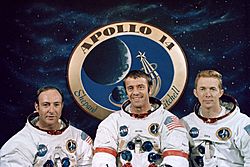 Left to right: Mitchell, Shepard, Roosa |
|
Apollo 14 was a very important space mission. It was the eighth time humans flew in the Apollo program. It was also the third time astronauts landed on the Moon. The mission lasted nine days. It launched from Earth on January 31, 1971. The astronauts landed on the Moon on February 5, 1971.
The Lunar Module, named Antares, landed in a place called the Fra Mauro formation. This was the same spot that the Apollo 13 mission had tried to reach. During their time on the Moon, the astronauts went on two spacewalks. They collected about 93 pounds (42 kg) of moon rocks. They also did many science experiments.
The crew included Commander Alan Shepard, who was the first American in space. He famously hit two golf balls on the Moon with a special club! The Command Module Pilot was Stuart Roosa. He took hundreds of tree seeds into space. Many of these seeds grew into special trees called Moon trees when they returned to Earth. The Lunar Module Pilot was Dr. Edgar Mitchell.
Contents
What was Apollo 14's Goal?
The main goal of Apollo 14 was to explore the Fra Mauro formation on the Moon. This area was chosen because scientists thought it held clues about how the Moon was formed. The mission also aimed to set up scientific equipment. This equipment would help study the Moon's inside.
The Astronauts of Apollo 14
The crew of Apollo 14 were three brave astronauts:
- Alan B. Shepard Jr.: He was the mission commander. He was the first American to travel into space in 1961.
- Stuart A. Roosa: He was the pilot of the Command Module, Kitty Hawk. He stayed in orbit around the Moon.
- Edgar D. Mitchell: He was the pilot of the Lunar Module, Antares. He landed on the Moon with Alan Shepard.
Journey to the Moon
The Apollo 14 mission began with a powerful Saturn V rocket launch. This happened at Kennedy Space Center in Florida. The rocket carried the Command Module Kitty Hawk and the Lunar Module Antares.
After reaching space, the spacecraft traveled towards the Moon. When they got close, the Kitty Hawk orbited the Moon. The Antares then separated from Kitty Hawk and headed down to the Moon's surface.
Landing on the Moon
On February 5, 1971, Alan Shepard and Edgar Mitchell landed the Lunar Module Antares on the Moon. They landed in the Fra Mauro formation. This area has many hills and craters. It was a challenging place to land.
Exploring the Moon's Surface
Shepard and Mitchell spent about 33 hours on the Moon. They did two spacewalks, also called Extravehicular Activities (EVAs).
- First Spacewalk: They set up the Apollo Lunar Surface Experiments Package (ALSEP). This was a set of scientific tools. They also collected rock samples.
- Second Spacewalk: They walked towards a large crater called Cone Crater. They collected more rocks and took photos. They used a special cart to carry their tools and samples.
During their second spacewalk, Alan Shepard famously hit two golf balls. He used a tool handle as a golf club. This was a fun moment that showed how far humans had come in space exploration.
Moon Rocks and Experiments
The astronauts collected 93.2 pounds (42.3 kg) of Moon rocks and soil. These samples helped scientists learn about the Moon's history. One famous rock was called "Big Bertha". It was one of the largest rocks brought back from the Moon.
The ALSEP equipment they set up included:
- A seismometer: This measured "moonquakes" to study the Moon's inside.
- A solar wind experiment: This measured particles from the Sun.
- Other tools: These measured the Moon's atmosphere and magnetic field.
The Journey Home
After their time on the Moon, Shepard and Mitchell launched from the Moon's surface in the top part of the Lunar Module. They rejoined Stuart Roosa in the Kitty Hawk orbiting the Moon. The Lunar Module was then left behind.
The three astronauts then began their journey back to Earth. The Kitty Hawk splashed down safely in the South Pacific Ocean on February 9, 1971. The crew was picked up by the USS New Orleans.
What are Moon Trees?
Stuart Roosa carried hundreds of tree seeds on the Apollo 14 mission. These seeds orbited the Moon with him in the Kitty Hawk. When they returned to Earth, many of these seeds were planted. They grew into trees called "Moon trees". These trees are a living reminder of the Apollo 14 mission. They are planted in many places around the world.
Finding the Landing Site Today
In June 2009, a NASA spacecraft called the Lunar Reconnaissance Orbiter (LRO) took pictures of the Apollo 14 landing site. The photos clearly showed the base of the Lunar Module. You could even see the astronauts' footprints on the Moon's surface! This shows how well preserved the landing sites are.
Images for kids
-
The Apollo 14 launch vehicle is rolled out from the Vehicle Assembly Building, November 9, 1970
-
Lunar surface television showing Shepard taking a couple of golf swings
See also
 In Spanish: Apolo 14 para niños
In Spanish: Apolo 14 para niños


